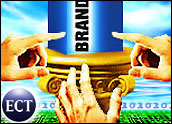
I have enjoyed reading Clayton Christensen’s books on disruptive innovation and observing how many of the concepts articulated in his books have played out in the CRM market and beyond. With the theory in mind, it has been fascinating to watch as smart people have behaved in ways that are either predictably on target or way off the mark. One of the more interesting chess matches to watch over several years has been the growing importance of hosting in the CRM market.
Disruptions Lose Customers
Christensen’s theory says that a disruptive innovation gains a foothold among customers who are unserved or underserved by the mainstream product. At that point the disruptive innovation is no match for the up-market product in features or functionality, but for the underserved, it is better than nothing and its low cost makes it attractive. Gradually, the product that wasn’t quite robust enough becomes more robust through continuing innovation. It then begins to head up market to where more well-heeled customers are and where it starts to displace the incumbent.
The lower end of the incumbent’s niche is not highly profitable and in the early stages, the incumbent is happy to retreat up market to more lucrative business. But the advance of the disruptor continues and the incumbent finally has to decide to stay and fight or continue to lose increasingly valuable market share. By the time the incumbent realizes it is in a serious struggle, it is frequently too late to regain lost share and the strategy instead is to co-opt the disruptive innovation.
Think of the Japanese car industry’s introduction into the US market and you have the complete and disturbing picture. In the 1980s, Japanese cars were small and cheap but they appealed to a large swath of new consumers just starting careers and in need of reliable and inexpensive transportation. Japanese car introduction also coincided with a heightened interest in high-quality manufacturing as well as embedding micro-processors to optimize engine function. The incumbent U.S. industry gave a collective yawn and over the next 25 years GM’s market share (just to pick one) went from about 50 percent of the U.S. market to just over a quarter today.
If you look at CRM you can trace a similar trajectory with respect to hosting in a greatly truncated five-year time span. Although most of the disruptive innovators in what was then called the application service provider (ASP) market eventually failed, a few got the business model right and began moving up market to the point that today hosting, or on-demand deployment, is one of the most popular forms of CRM delivery.
Bowing to Competition
What happens next in the disruptive time line is also interesting. In a strategy summed up by the slogan, “If you can’t beat ’em, join ’em,” the incumbent decides to embrace the innovation, but too often that approach is a thinly veiled up-sell strategy. In the auto industry the incumbents reversed course and tried to build small cars, but their hearts were not in it and that showed in the products. In CRM, many vendors have adopted a hybrid approach in which they give the customer the choice and ability to start out hosted and convert to a traditional on premises solution. I don’t have any data about the conversion rate but I could make an educated guess, and it would not be flattering.
Even worse, while the incumbent is now hard at work defending the low end of the market, the disruptor continues its assault on the more lucrative high end with relative ease. Remember the fanfare when Acura, Lexus and Infiniti were announced? We seem to be at the same point in the CRM market today. Companies like Salesforce.com are going after larger conventional customers while companies like Siebel are finally delivering a good on-demand product to the SMBs.
The situation is not as black and white as it seems. Salesforce still does a lot of business in the low and middle parts of the market and Siebel did deliver over a million seats of conventional CRM just last year — more than Salesforce.com’s entire customer base.
But time may not be on Siebel’s side. The company now has built-in expectations from its investors that it will be able to produce the kinds of margins and returns it did when the CRM market was a very different place. On the other hand, from the get-go, Salesforce.com’s shareholders have been educated about a very different margin and profit curve. All of the cost cutting in the world will not enable Siebel to compete with a low cost model unless Siebel also changes its model. The best way to do that is to change the competitive dimension.
ROI Issues
For a long time, the competition in CRM has been centered on lowering the cost of deployment to show a positive ROI. But as I have written elsewhere, software is not a U.S. Treasury security for which you can calculate a yield; to get your money’s worth (e.g. ROI) you have to actually use it to accomplish something. Increasingly, the dimensions along which CRM supremacy will be contended must include customer centric processes that drive customer loyalty instead of one-time transactions whose success is measured by customer satisfaction, which is as fleeting as the transaction itself.
The reason is simplr; most markets are mature at this point — it’s hard to sell more cell phones or iPods if a high percentage of the market already has one. In mature markets, growth comes from repeat transactions with existing customers. And those transactions are driven by customer-centric business processes that need to be supported by systems that do much more than manage transactions. CRM systems that do better at supporting holistic processes would seem to be the logical choice as the new competitive dimension.
Peppers and Rogers have a new book, which I have mentioned previously — Return on Customer: Creating Maximum Value from Your Scarcest Resource — that ultimately deals with the idea of customer loyalty or treating customers so well that they come back and buy more. So far no one really seems to be taking customer loyalty and return on customer (ROC) seriously but I expect that will change. It may even be the next disruptive innovation in CRM.
Denis Pombriant is a well known thought leader in CRM and the founder and managing principal of the Beagle Research Group, a CRM market research firm and consultancy. Pombriant’s latest report, CRM WizKids: Taking CRM to the Next Level, identifies emerging CRM leaders and their innovative technologies. In 2003, CRM Magazine named Pombriant one of the most influential executives in the CRM industry. Pombriant is currently working on a book to be published next year. He can be reached at [email protected]













































